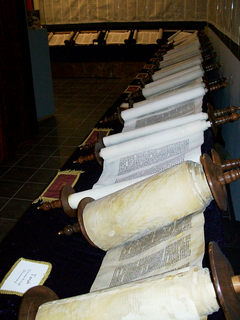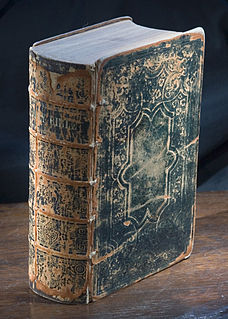
Apocrypha are the biblical books received by the early Church as part of the Greek version of the Old Testament, but not included in the Hebrew Bible, being excluded by the non-Hellenistic Jews from their canon. Their position in Christian usage has been ambiguous.

The Bible is a collection of religious texts, writings, or scriptures sacred to Jews, Samaritans, Christians, Rastafaris, and others. It appears in the form of an anthology, a compilation of texts of a variety of forms that are all linked by the belief that they are collectively revelations of God. These texts include theologically-focused historical accounts, hymns, prayers, proverbs, parables, didactic letters, admonitions, essays, poetry, and prophecies. Believers also generally consider the Bible to be a product of divine inspiration.

The deuterocanonical books are books and passages considered by the Catholic Church, the Eastern Orthodox Church, the Oriental Orthodox Churches and the Assyrian Church of the East to be canonical books of the Old Testament, but that Protestant denominations do not regard as part of the biblical canon. They date from 300 BC–AD 100, mostly from 200 BC–AD 70, before the definite separation of the Christian church from Judaism. While the New Testament never directly quotes from or names these books, the apostles most frequently used and quoted the Septuagint, which includes them. Some say there is a correspondence of thought, and others see texts from these books being paraphrased, referred or alluded to many times in the New Testament, particularly in the Pauline epistles, depending in large measure on what is counted as a reference.

The New Testament (NT) is the second division of the Christian biblical canon. It discusses the teachings and person of Jesus, as well as events in first-century Christianity. The New Testament's background, the first division of the Christian Bible, is called the Old Testament, which is based primarily upon the Hebrew Bible; together they are regarded as sacred scripture by Christians.

The Old Testament is the first division of the Christian biblical canon, which is based primarily upon the 24 books of the Hebrew Bible or Tanakh, a collection of ancient religious Hebrew writings by the Israelites. The second division of Christian Bibles is the New Testament, written in the Koine Greek language.

The Hebrew Bible or Tanakh, is the canonical collection of Hebrew scriptures, including the Torah. These texts are almost exclusively in Biblical Hebrew, with a few passages in Biblical Aramaic.

The oldest surviving Hebrew Bible manuscripts—including the Dead Sea Scrolls—date to about the 2nd century BCE (fragmentary) and some are stored at the Shrine of the Book in Jerusalem. The oldest extant complete text survives in a Greek translation called the Septuagint, dating to the 4th century CE. The oldest extant manuscripts of the vocalized Masoretic Text, date to the 9th century CE. With the exception of a few biblical sections in the Prophets, virtually no biblical text is contemporaneous with the events it describes.

Biblical inerrancy is the belief that the Bible "is without error or fault in all its teaching"; or, at least, that "Scripture in the original manuscripts does not affirm anything that is contrary to fact". Some equate inerrancy with biblical infallibility; others do not. The belief is of particular significance within parts of evangelicalism, where it is formulated in the "Chicago Statement on Biblical Inerrancy".

Biblical studies is the academic application of a set of diverse disciplines to the study of the Bible. For its theory and methods, the field draws on disciplines ranging from ancient history, historical criticism, philology, textual criticism, literary criticism, historical backgrounds, mythology, and comparative religion.

Biblical criticism is the use of critical analysis to understand and explain the Bible. During the eighteenth century, when it began as historical-biblical criticism, it was based on two distinguishing characteristics: (1) the scientific concern to avoid dogma and bias by applying a neutral, non-sectarian, reason-based judgment to the study of the Bible, and (2) the belief that the reconstruction of the historical events behind the texts, as well as the history of how the texts themselves developed, would lead to a correct understanding of the Bible. This set it apart from earlier, pre-critical methods; from the anti-critical methods of those who oppose criticism-based study; from later post-critical orientation, and from the many different types of criticism which biblical criticism transformed into in the late twentieth and early twenty-first centuries.

Biblical hermeneutics is the study of the principles of interpretation concerning the books of the Bible. It is part of the broader field of hermeneutics, which involves the study of principles of interpretation, both theory and methodology, for all forms of communication, nonverbal and verbal.

The historical-grammatical method is a Christian hermeneutical method that strives to discover the biblical authors' original intended meaning in the text. According to the historical-grammatical method, if based on an analysis of the grammatical style of a passage, it appears that the author intended to convey an account of events that actually happened, then the text should be taken as representing history; passages should only be interpreted symbolically, poetically, or allegorically if to the best of our understanding, that is what the writer intended to convey to the original audience. It is the primary method of interpretation for many conservative Protestant exegetes who reject the historical-critical method to various degrees, in contrast to the overwhelming reliance on historical-critical interpretation in biblical studies at the academic level.

Disputes regarding the internal consistency and textual integrity of the Bible have a long history.
James A. Sanders was an American scholar of the Old Testament/Hebrew Bible and one of the Dead Sea Scrolls editors. He was the first to translate and edit the Psalm Scroll, which contained a previously unknown psalm. Sanders retired in the late 1990s, but still published and lectured regularly.

The Old Testament is the first section of the two-part Christian biblical canon; the second section is the New Testament. The Old Testament includes the books of the Hebrew Bible (Tanakh) or protocanon, and in various Christian denominations also includes deuterocanonical books. Orthodox Christians, Catholics and Protestants use different canons, which differ with respect to the texts that are included in the Old Testament.

A biblical canon, also called canon of scripture, is a set of texts which a particular Jewish or Christian religious community regards as authoritative scripture. The English word canon comes from the Greek κανών, meaning "rule" or "measuring stick". Christians were the first to use the term in reference to scripture, but Eugene Ulrich regards the notion as Jewish.
Brevard Springs Childs was an American Old Testament scholar and Professor of Old Testament at Yale University from 1958 until 1999, who is considered one of the most influential biblical scholars of the 20th century.

Historical criticism, also known as the historical-critical method or higher criticism, is a branch of criticism that investigates the origins of ancient texts in order to understand "the world behind the text". While often discussed in terms of Jewish and Christian writings from ancient times, historical criticism has also been applied to other religious and secular writings from various parts of the world and periods of history.
Christopher R. Seitz is an American Old Testament scholar and theologian known for his work in biblical interpretation and theological hermeneutics. He is the senior research professor of biblical interpretation at Toronto School of Theology, Wycliffe College. He is also an ordained priest in the Episcopal Church, and served as canon theologian in the Episcopal Diocese of Dallas (2008-2015).
Gerald Henry Wilson was an American Old Testament scholar. He served as professor of Old Testament and Biblical Hebrew at Azusa Pacific University.








